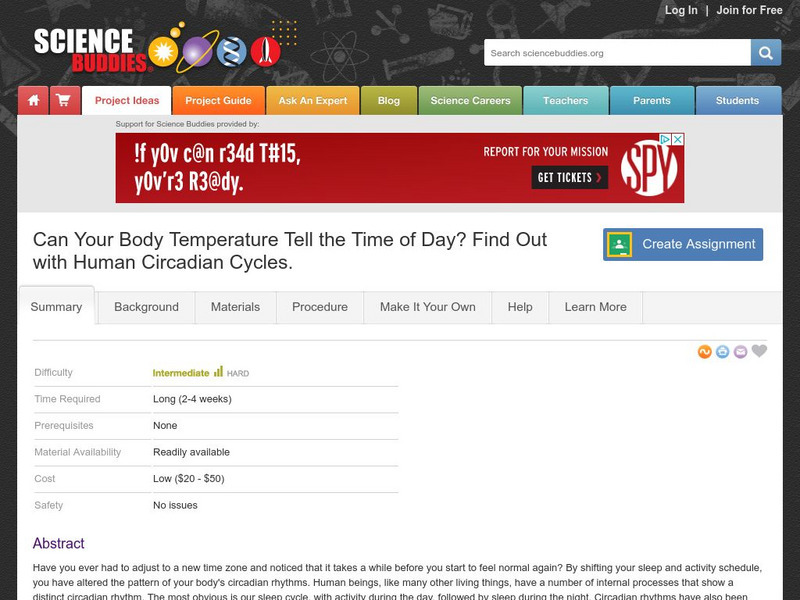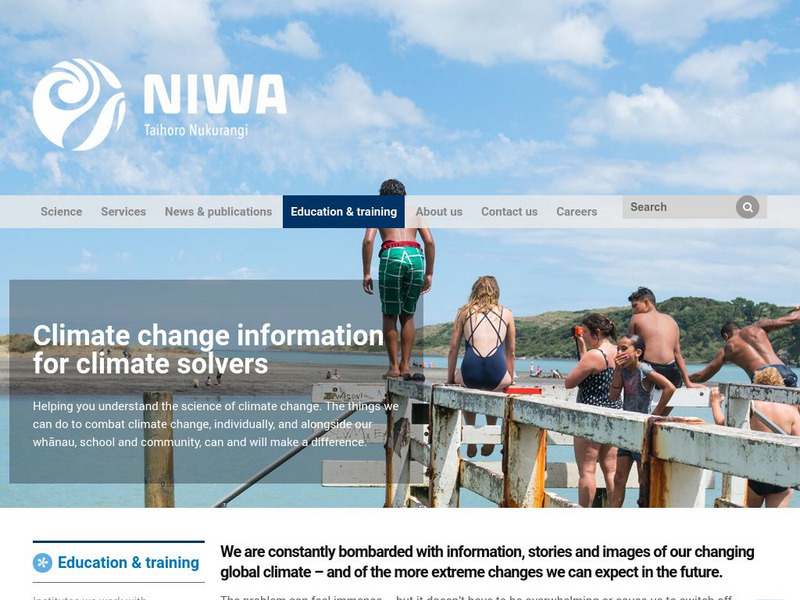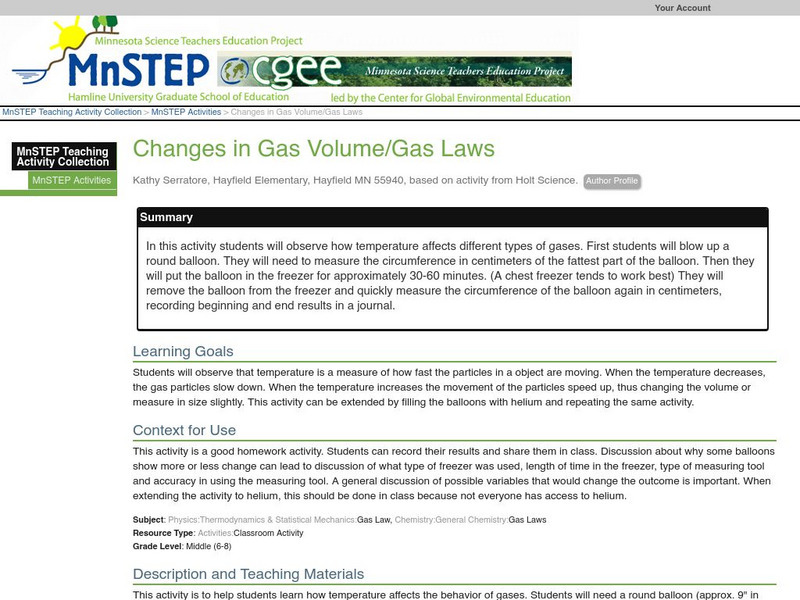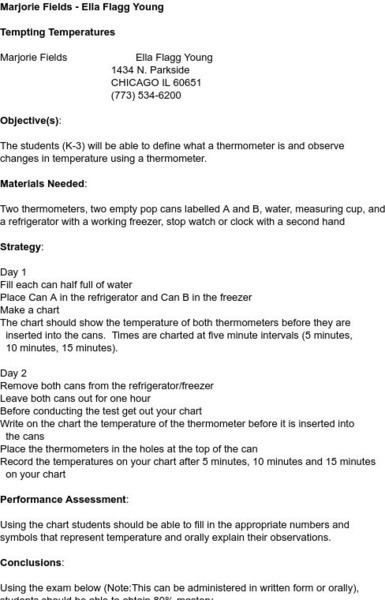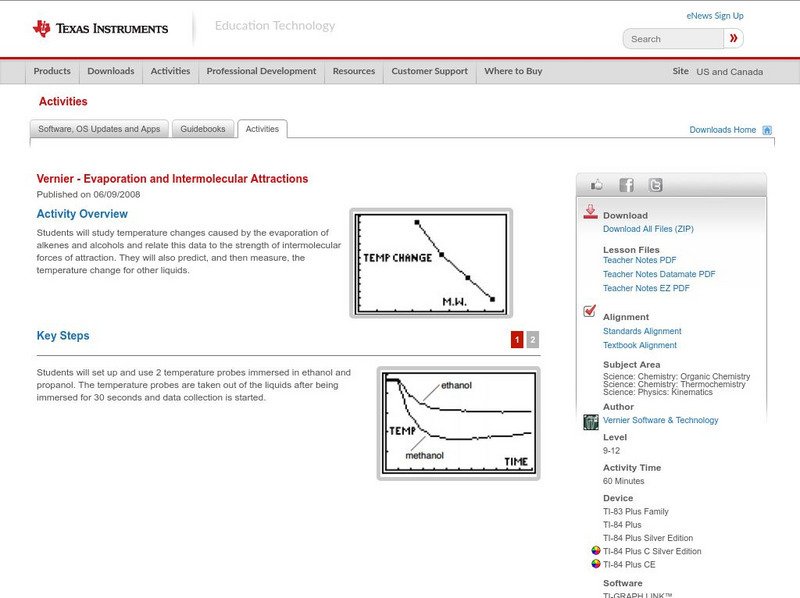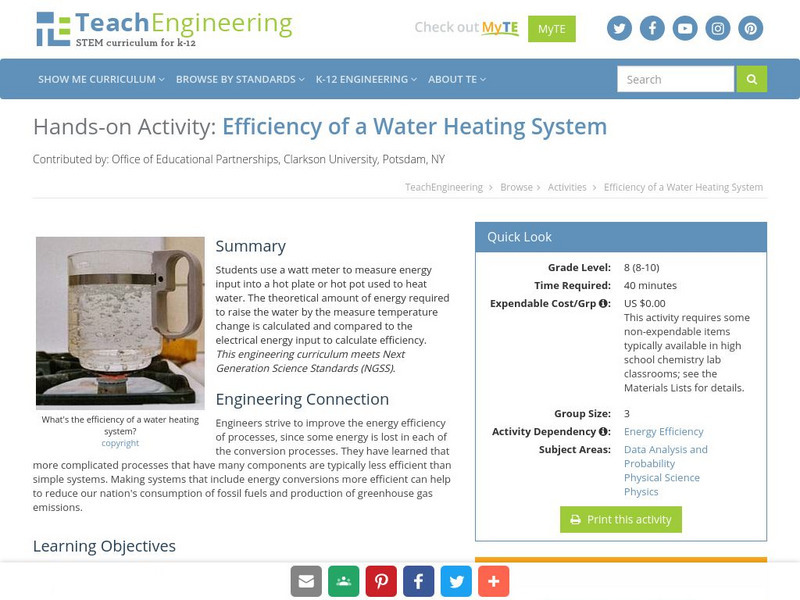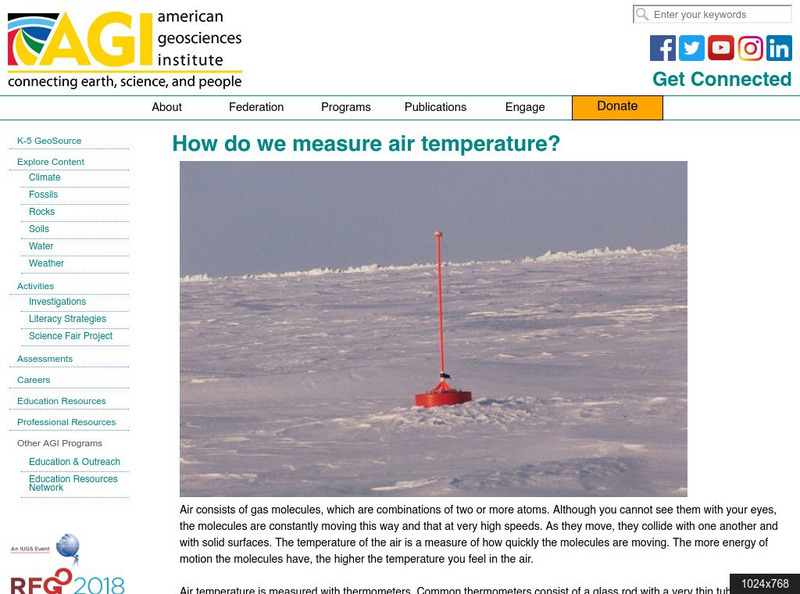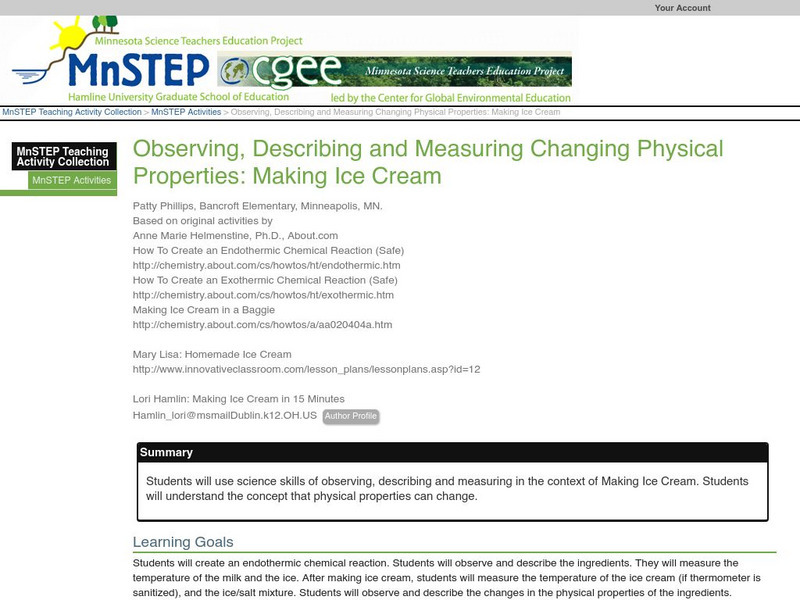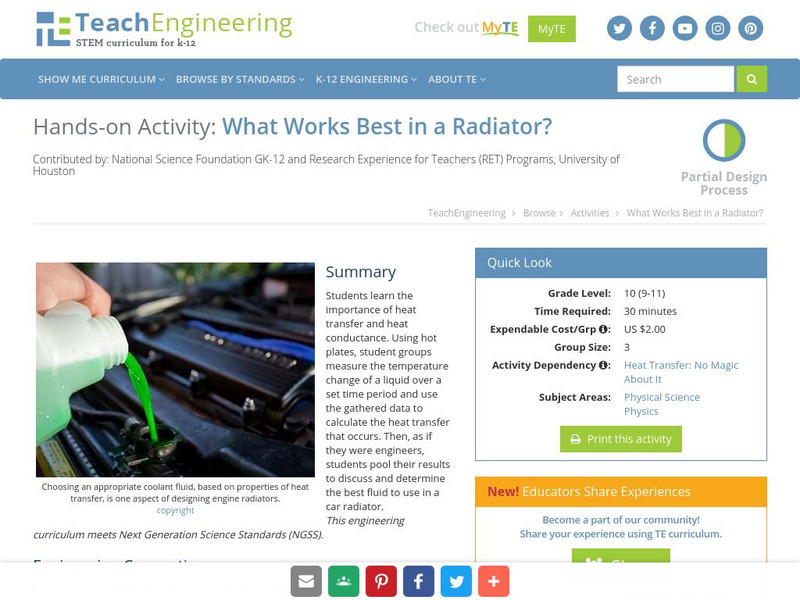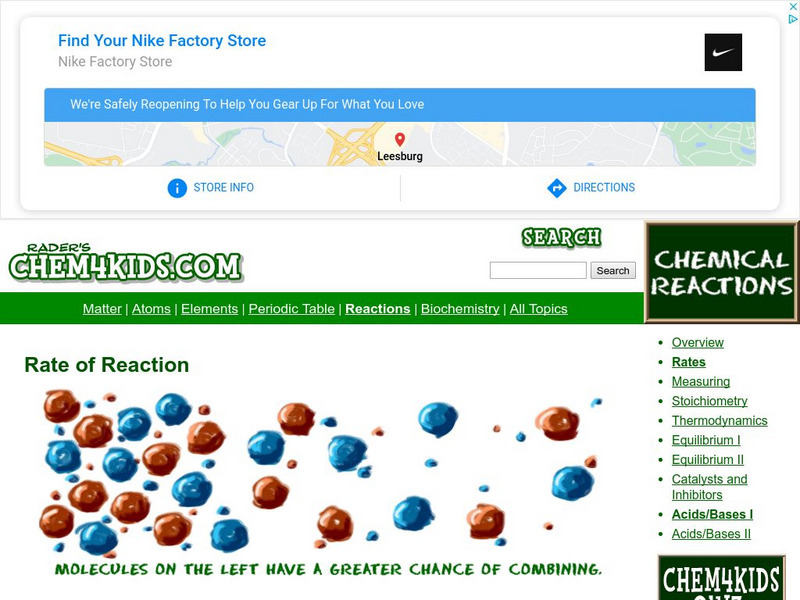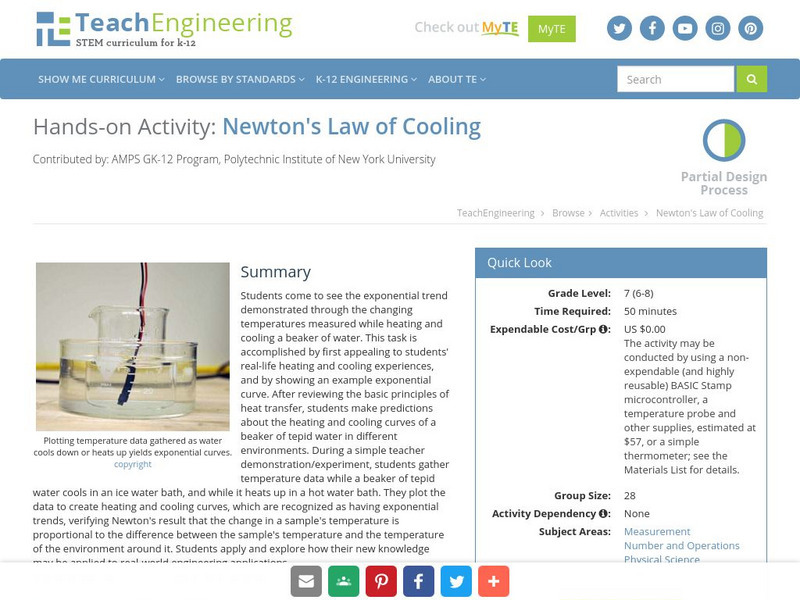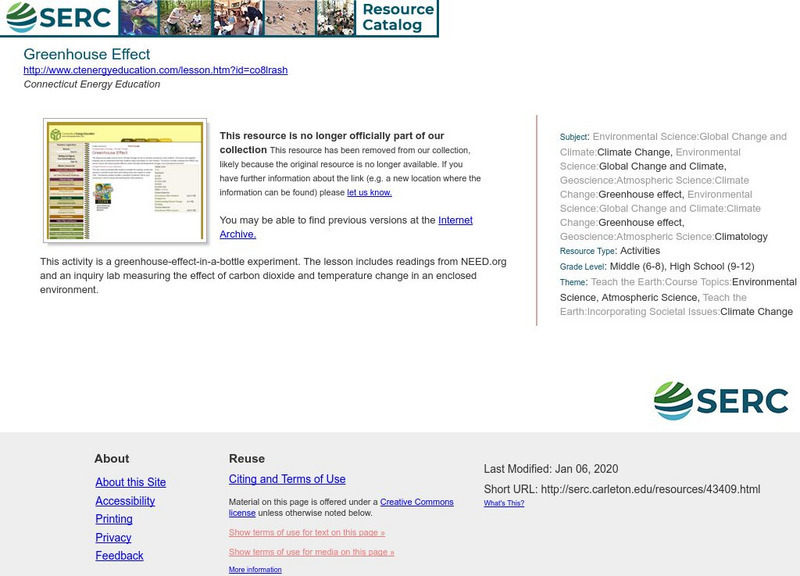Physics Classroom
The Physics Classroom: Thermal Physics: Measuring the Quantity of Heat
Through interactive exercises and illustrated example problems, students learn about specific heat capacity and measuring the quantity of heat.
Science Buddies
Science Buddies: Can Your Body Temperature Tell the Time of Day?
If you have ever had to adjust to a new time zone, you have noticed that it takes a while before you start to feel normal again. By shifting your sleep and activity schedule, you have altered the pattern of your body's circadian rhythms....
Other
Niwa: Climate Change, Global Warming, and Greenhouse Gases
Want to learn more about climate change, global warming, and greenhouse gases? This web page contains links to websites around the world concerned with providing information about these. Topics include climate shift, greenhouse effect,...
TryEngineering
Try Engineering: Temperature Tactics
Students practice the engineering design process as they explore devices used to measure changes in temperature. They work in teams to design, build, test, and evaluate their own temperature gauge made from everyday materials.
Utah Education Network
Uen: Heat Sources Feeling Hot Hot Hot!
How does temperature vary in the sunshine and shade. Find out as you participate in this lab activity. The resource also has some online thermometers for you to read.
Science Education Resource Center at Carleton College
Serc: Changes in Gas Volume/gas Laws
In this activity students will observe how temperature affects different types of gases. First students will blow up a round balloon. They will need to measure the circumference in centimeters of the fattest part of the balloon. Then...
Science and Mathematics Initiative for Learning Enhancement (SMILE)
Smile: Tempting Temperatures
In this lesson plan students learn how to use a thermometer and compare changes in temperature using water in the fridge and water in the freezer. Helps students create charts to analyze data.
Texas Instruments
Texas Instruments: Evaporation and Intermolecular Attractions
Students will study temperature changes caused by the evaporation of alkenes and alcohols and relate this data to the strength of intermolecular forces of attraction. They will also predict, and then measure, the temperature change for...
TeachEngineering
Teach Engineering: Efficiency of a Water Heating System
Students use a watt meter to measure energy input into a hot plate or hot pot used to heat water. The theoretical amount of energy required to raise the water by the measure temperature change is calculated and compared to the electrical...
American Geosciences Institute
American Geosciences Institute: How Do We Measure Air Temperature?
Find out how scientists measure the air temperature to accurately report the weather.
Science Education Resource Center at Carleton College
Serc: Observing,describing, Measuring Changing Physical Prop: Making Ice Cream
Young scholars will create an endothermic chemical reaction by making ice cream. They will observe, describe, and measure the ingredients. After making ice cream, students will measure the temperature of the ice cream and the ice/salt...
Science Education Resource Center at Carleton College
Serc: Precision in Measurement Finding When an Object Changes Color
This activity is an introduction to measurement, especially precision. Young scholars should know the difference between precision and accuracy in measurement. They will be able to answer the questions: At what temperature does the mood...
Science Buddies
Science Buddies: I'm Trying to Breathe Here! Dissolved Oxygen vs. Temperature
To survive, we need oxygen in the air we breathe. Oxygen is also essential for most aquatic organisms, but there is much less oxygen available in water than in air. Learn how to measure dissolved oxygen and then see how oxygen...
TeachEngineering
Teach Engineering: What Works Best in a Radiator?
Students learn the importance of heat transfer and heat conductance. Using hot plates, student groups measure the temperature change of a liquid over a set time period and use the gathered data to calculate the heat transfer that occurs....
Chem4kids
Chem4 Kids: Reaction Rates
This Chem4Kids.com site explores the rate of reactions. Content focuses on forces that change the speed of reactions, and measuring rates.
Georgia State University
Georgia State University: Hyper Physics: Heat of Fusion
The heat of fusion is defined and described. A graphical representation of the heat of vaporization is given. A method for measuring and calculating the heat of fusion is also presented and explained.
Creative Science Centre
Creative Science Centre: An Electric Thermometer
Instructions for how to make an electrical thermometer. The electrical thermometer works like this - the design consists of four resistors each made from about 40 meters of very thin copper wire. The electrical resistance of wire changes...
TeachEngineering
Teach Engineering: Newton's Law of Cooling
Students come to see the exponential trend demonstrated through the changing temperatures measured while heating and cooling a beaker of water. This task is accomplished by first appealing to students' real-life heating and cooling...
Texas Instruments
Texas Instruments: Designing Hot and Cold Packs
in this activity, students calculate the molar enthalpy of dissolving for three ionic solids, and use this information to design a cold pack. In this experiment they measure the heat changes which occur from various salts dissolving in...
Texas Instruments
Texas Instruments: Heat Transfer by Conduction
The purpose of this activity is to monitor the transfer of heat between 2 materials by measuring the temperature changes in them.
Science Education Resource Center at Carleton College
Serc: Greenhouse Effect
An inquiry lab measuring the effect of carbon dioxide and temperature change in an enclosed environment to simulate the greenhouse effect.
TeachEngineering
Teach Engineering: Weather Basics
Students are introduced to the basics of the Earth's weather. Concepts include fundamental causes of common weather phenomena such as temperature changes, wind, clouds, rain and snow. The different factors that affect the weather and the...
Texas Instruments
Texas Instruments: Who Says a Watched Pot Never Boils?
In this activity, students' will investigate what causes phase changes in matter.They use a temperature sensor to measure the temperature of a substance and identify visual clues to the phase changes.
Science Education Resource Center at Carleton College
Serc: Whither Arctic Sea Ice?
In this lesson students will access and analyze sea ice data. By the end of the lesson students should be able to measure the seasonal variations in sea ice extent, discover long-term changes occurring in sea ice extent, visualize the...



